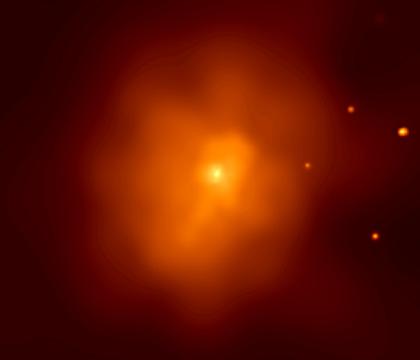Chandra Probes Nature of Dark Matter
The cluster of galaxies EMSS 1358+6245 about 4 billion light year away in the constellation Draco is shown in this Chandra image. When combined with Chandra's X-ray spectrum, this image allowed scientists to determine that the mass of dark matter in the cluster is about 4 times that of normal matter.
The relative percentage of dark matter increases toward the center of the cluster. Measuring the exact amount of the increase enabled astronomers to set limits on the rate at which the dark matter particles collide with each other in the cluster. This information is extremely important to scientists in their quest to understand the nature of dark matter, which is thought to be the most common form of matter in the universe.
|
||||||||||||||||||||||||
The cluster of galaxies EMSS 1358+6245 is about 4 billion light years away in the constellation Draco and is shown in this Chandra X-ray Observatory image. When the image data is combined with Chandra's X-ray spectrum, scientists determined that the mass of dark matter in the cluster is about 4 times that of normal matter. The image captures the galaxy's brightness in X-ray light, revealing its underlying structure and features. In the center of the image, there is a bright yellow core. This represents the core of the galaxy, which emits high levels of X-ray radiation due to the presence of a supermassive black hole at its center. The surrounding areas of the image are less bright, but still visible in tones of orange, showcasing the galaxy's diffuse halo of gas and dust. Compared to familiar everyday objects, the inner brighter structure resembles a blurry guitar with the head pointing to 7 o'clock.





